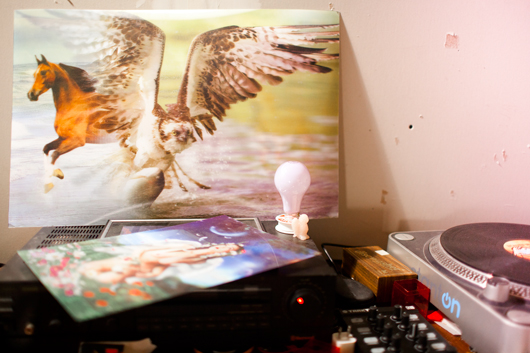In the Studio: Teengirl Fantasy
Logan Takahashi and Nick Weiss have been making music for what seems like their whole […]
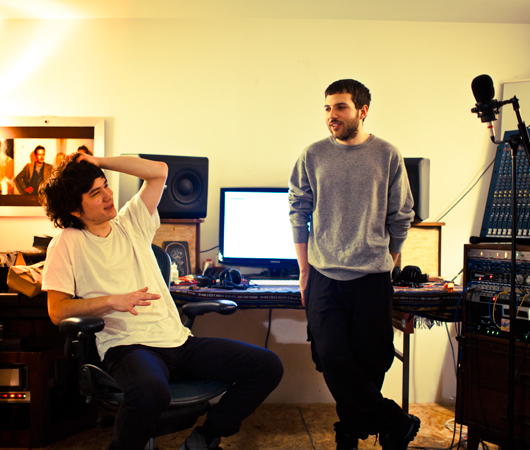
Logan Takahashi and Nick Weiss have been making music for what seems like their whole lives. Experimenting with hip-hop beats and other electronic sounds since grade school, it wasn’t until they met at Oberlin College in Ohio that the two budding artists joined forces under the name Teengirl Fantasy. The duo honed its unique style of loose, dreamy house music while finishing up their respective undergraduate studies, which, in 2010, culminated as a debut LP for Merok and True Panther, the lush 7AM, and its powerful lead single, “Cheaters.” Now, Takahashi and Weiss are closer than ever to unveiling their sophomore album via R&S this year, giving us the perfect excuse to get into the pair’s Brooklyn studio and talk to them about the gear that helps make Teengirl Fantasy’s excellent tunes.
XLR8R’s In the Studio series is sponsored by Dubspot.
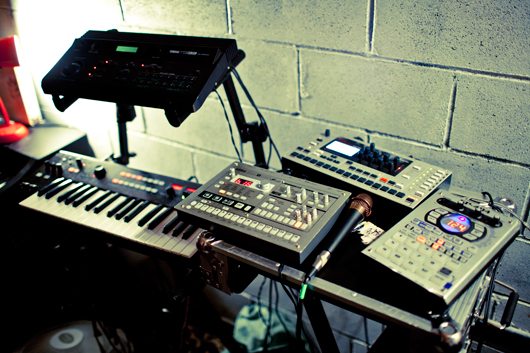
XLR8R: What’s one of the instruments you guys would start writing a song with?
Logan Takahashi: A lot of times, this Elektron Monomachine. It’s really good for sequencing melodies—synth lines, basically. A lot of times, we’ll come up with basic loops just to jam on top of, and the sampler is good for that. Nick has a Korg WaveStation rackmount [synth]. It’s like a digital vector synth, an FM synth. A lot of the songs on this album are using MIDI to control rackmount synths and come up with patterns and stuff.
XLR8R: Of all this, what would you say is your most cherished piece of equipment?
LT: Oh, man. [laughs] This Yamaha TG-33 has some amazing sounds, really good Digital Revolution, like, ’90s digital sounds, which we’re both really into right now.
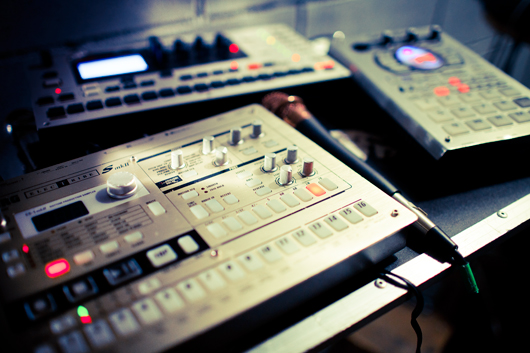
XLR8R: Where’d you get it?
LT: I got this in Berlin, actually. It was just at a street market. This dude sold it to me for 200 euros, maybe. Maybe it was less than that. It wasn’t that expensive.
XLR8R: Did you know what you were buying?
LT: It was more like a whim. I wasn’t really planning on getting anything, but I thought, “I should just do it.” This thing looks awesome, and it turned out to be a really good purchase.
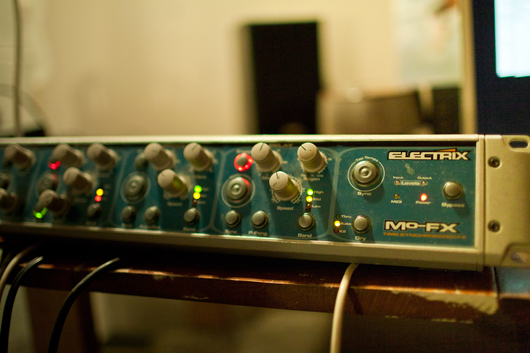
XLR8R: Do you have any gear that you used on the first record that you aren’t using currently?
LT: Yeah. I got this Korg ElecTribe ES-1 MKII when I was in high school, like, when I was 16 or 17. This has always been in [Teengirl Fantasy’s music], but I’m gonna shy away from using it in the future. But yeah, on 7AM I used this Electribe and my sampler, but I didn’t really get to deep into programming. The new one has more sequencing and patterns, I guess. This Electrix MO-FX effects unit is awesome, too. I got this one from Jeff Ryan from the band Excepter. I’ve been a huge Excepter fan since I was a teenager. They’re kind of one of the groups that got me into electronic music. He just posted on Facebook that he was selling this, and I’m just glad that I got it. It sounds like Excepter, which is cool.
XLR8R: What’re the effects you use the most from it?
LT: This has a really cool flange. If you put it on a really shallow depth setting, it has a really slow, subtle flange that I like. The delay is just, like, you can get lost in it if you’re under the influence or something. [laughs] We used it on this track from the new album that we’re calling, well, the working title is “Vector Spray.” It’s on, like, three of the new tracks.
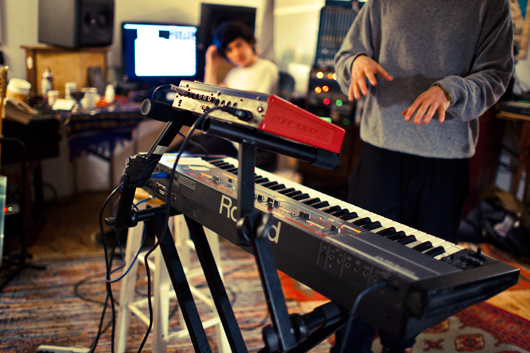
XLR8R: So, Nick, give us a rundown of your setup.
Nick Weiss: On the last album, all I mostly used was the Roland Juno-106 and the Akai MPC-1000. I’ve played the Juno-6 and the 60, which I’m told are punchier and better sounding, but for some reason, the sound of the 106 is what I like the best. It’s a little bit softer and it has a really nice polyphony function where it’ll hold out the chords until you play a new chord. I use that a lot in most of our songs, the kind of sustained chords. The MPC I’ve had a for a really long time. I mean, I’ve made hip-hop beats and stuff on it [since] before high school. More recently, Logan and I both picked up these digital rackmount synths. I just got this Korg WaveStation SR on eBay. I heard one demo song of it on YouTube, and was so into it. And it was really cheap.
XLR8R: What about it were you so into?
NW: The timbre of the sound. You can do heavy editing of the sounds, cuz it’s a vector synth and has four different points that you can mix between so the sounds slowly mutate. We used this on a lot of the new album. There are sounds on this that you’ve definitely heard before, like in Beyond the Mind’s Eye. A lot of composers within the later Digital Revolution timeframe used this.
LT: It’s pretty iconic.
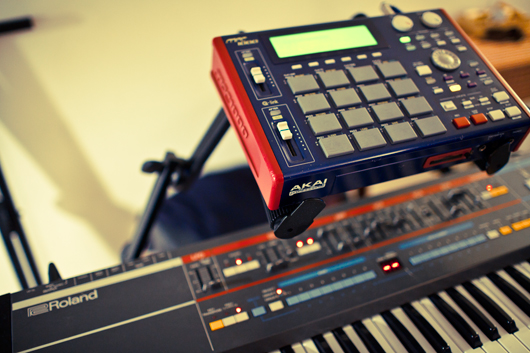
XLR8R: Did you go looking for this?
NW: I really didn’t know that much about it, I just came across that demo song online and saw it on eBay. Before, I was only using the Juno, which you can do a lot with, but it’s still analog, so the types of sounds are limited. So I use the Juno to trigger the MIDI, but I’m recording the audio of the WaveStation and the Juno at the same time, so it’s a combination. They mix nicely together.
XLR8R: Do you use a lot of the WaveStation’s presets as is?
NW: I use mostly presets. [laughs] You can edit the sounds, but it’s a little bit difficult, because it’s just this two-line LCD screen and 10 little buttons. That’s your whole interface. I started learning how to edit on it. I can do very very minute things, like change the effects on patches, but I just haven’t gone deep enough into it. But the patches are already awesome.
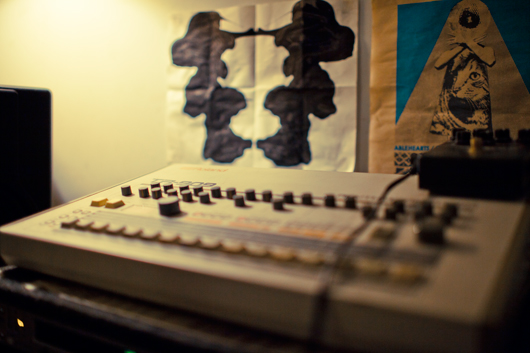
XLR8R: You guys seem to have a singular love for vintage gear. Do you try as much as possible to use hardware over software?
NW: I mean, we have no rules.
LT: In general, if we have access to analog gear, we’re going to use that.
NW: Or combine the two. We record everything live, but that doesn’t mean we don’t edit in Logic or write stuff in Ableton. We have some sessions that are just bonkers.
